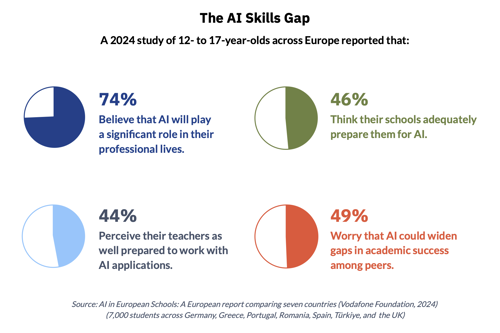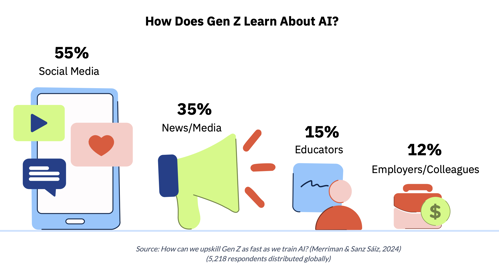14 August 2025
Empowering Educators: What the New AI Literacy Framework Means for Schools and Teachers
As education wrestles with the rapid advances of AI, the newly published AI Literacy Framework, a draft released in May 2025 by the European Commission (EC) and the OECD, offers schools and colleges a timely compass. Supported by Code.org and international experts, it lays out a forward-thinking blueprint for embedding AI understanding across teaching and leadership roles globally .
AI literacy represents the technical knowledge, durable skills, and future- ready attitudes required to thrive in a world influenced by AI. It enables learners to engage, create with, manage, and design AI, while critically evaluating its benefits, risks, and ethical implications.
Why This Matters Now
-
A Foundational Shift
The framework redefines AI literacy not as a niche tech skill, but as a core educational competency—one that includes not just knowledge, but critical thinking, creation, ethical reflection, and citizenship in an AI‑shaped world .
-
Four Key Domains—22 Competencies
Structured into “Engage with AI,” “Create with AI,” “Manage AI,” and “Design AI,” the framework identifies 22 specific competencies learners should develop, spanning from recognising AI in everyday tools to designing and stewarding AI-based solutions with social awareness .
-
Alignment with Broader Initiatives
It integrates existing European efforts—like PISA 2029, DigComp 2.2, the Digital Education Action Plan, and the EU AI Act—creating cohesion with ongoing educational policy goals .
-
Call to Action—Your Feedback Matters
This draft solicits input from educators, leaders, and stakeholders through consultations now and aims for a final release in 2026 with real-world examples and refined guidance .
CAS can help with AI
See CAS' AI support
See the AI resources
What This Means for AI Education Leaders
-
Blueprint for Strategy
Use the four-domain, 22-competency structure to craft AI literacy roadmaps that intersect with core subjects—e.g. integrating AI concepts in statistics or social sciences—and align with regional policy frameworks .
-
Structure for Professional Learning
Design CPD programs that build capabilities around each domain—starting with awareness (“engage”) and progressing toward student-led innovation (“create” and “design”).
-
Policy Embedding & Ethical Guardrails
The framework supports alignment with legal obligations (e.g. EU AI Act’s requirement that “deployers ensure staff have adequate AI literacy”).
-
Stakeholder Engagement
Schools & colleges can join consultations to shape the final framework, contributing practitioner insights.
Implications for Classroom Teachers
-
Concrete Competence Goals
Whether it’s spotting AI-generated content (“engage”), co-generating outputs with tools like LLMs (“create”), setting safe usage boundaries (“manage”), or helping students conceptualise AI systems (“design”)—the framework provides clear, actionable competencies to anchor lesson planning and assessment.
-
Cross-Subject Integration
AI isn’t confined to computer science. Teachers of humanities, sciences, and arts can weave AI topics into their disciplines—e.g., historical data biases, AI-assisted storytelling, or science experimentation supported by AI predictions .
-
Ethical & Critical Reflection
Emphasises prompting students to question AI’s transparency, fairness, and societal impact—not just how to use it .
-
Opportunities for Co-Design
Teachers can partner with peers or researchers to develop AI-integrated curricula—mirroring successful co-design models from prior innovation in education .
-
Foundations for Generative AI Literacy
As generative AI enters classrooms, educators may reference emerging frameworks that emphasise tool selection, prompt design, reflection, and responsible usage .

Moving Forward: Action Steps for Schools & Teachers
|
Role |
Recommended Next Steps |
|---|---|
|
AI Education Leaders |
1. Map existing curriculum to the framework’s competencies. 2. Launch school-wide AI literacy initiative and committees. 3. Provide feedback on the draft. |
|
Teachers |
1. Start with one domain (e.g., “engage with AI”) and embed into current lessons. 2. Use reflection prompts on AI use cases and ethics. 3. Join CPD or the CAS AI community to explore AI teaching. |
This May 2025 draft of the AI Literacy Framework isn’t just another policy document—it’s a call to rethink how we prepare learners to live, learn, and work in an AI-infused world. For educational leaders, it offers a strategic scaffold; for teachers, it delivers clarity, direction, and inspiration. By engaging now, providing feedback, and integrating its vision into our classrooms, we can shape a more informed, creative, and responsible future.











Discussion
Please login to post a comment